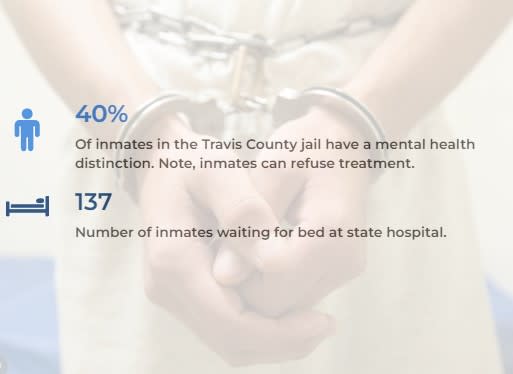What’s needed to make a diversion center successful?

AUSTIN (KXAN) — Law enforcement, prosecutors and elected officials point to the creation of a diversion center as a solution to address crime related to mental health and homelessness.
Travis County Commissioners unanimously passed a measure in March 2023 to create the facility.
A diversion center is meant to be an alternative to jail. In Travis County, the plan is to serve people accused of minor offenses or who are experiencing drug addiction or mental health issues for about 14 days and “help transition these patients to their next point of care.”
That last point — transitioning patients to their next point of care — currently concerns Travis County Sheriff Sally Hernandez. As the city and county continue to mold the details of the diversion center, she’s emphasizing the need to also focus on increasing resources for long-term services that patients can receive once they leave the center.
LEARN MORE: Background on the diversion center
“They have to have more long-term stabilization for it to be successful,” she said. “The diversion center is more than a building, and it has to be viewed as more than a building.”

Wraparound services in action
Lisa Bell, who once received a seven-year sentence for an “Engaging in Organized Crime” charge, shares the sheriff’s sentiment. Bell now serves on the board of Truth Be Told, a nonprofit that helps mentor women in prison to prepare them for a successful life when they get out.
Once I got out, it was scary.
Lisa Bell, nonprofit chair, on what it was like when she got out of prison

“What’s important when they’re being reacclimated is that they have those resources that say ‘hey, I can go here, and this job will hire me being an ex-felon,’ or ‘I can go here because I know I can receive help with housing,'” she said.
Bell credits services like these with who she was able to become once she left. While a release date is something to look forward to, it’s also daunting for people who have been incarcerated for years.
“Once I got out, it was scary,” she said. “I’m like ‘wow, what am I going to do for a job, who’s going to accept me for a job?'”
‘Gap in the system’: Addressing crime suspects’ mental health in Travis County
For Bell, Truth Be Told helped her on that front. She’s now in discussions with teams working on the diversion center to emphasize the importance of this kind of help.
Where we’re at with the diversion center now
The city and county are still negotiating contracts with groups who will actually run the diversion center, and there’s no set timeline on the project’s completion just yet.
A pilot diversion program will launch soon, though, according to Travis County Judge Andy Brown. It will be able to serve 25 people at a time.
Brown said his office is still trying to find the best provider for the pilot, and he wants to make sure it’s one that can provide comprehensive data that city and county leaders can use to model the full-scale diversion center after.
The creation of the center has long been a passion for Brown.
“The urgency for getting started as soon as possible… There are so many people sitting in our jail today that really just need mental health help,” he said.
During a commissioners court meeting this month, staff working on finding the right healthcare partners to run the diversion center said providers’ “connection to the broader continuum of care” to help patients long term is top of mind. They also discussed the needs Sheriff Hernandez addressed: wraparound services in spaces like mental health, employment and housing.
When KXAN asked Brown about wraparound services, he said “we’re doing great work on increasing the amount of supportive housing, we clearly need to do more. The city, the county, the nonprofits.”
The Travis County Jail does currently provide mental health resources for inmates.
Danny Smith, the director of inmate mental health programs, said there’s a mental health screening for everyone who comes into the jail. From there, staff will refer people they have competency concerns about to the courts. If a person is deemed incompetent to stand trial, they’ll be put on a waitlist to go to the state hospital.
He said the challenges his staff face on this front are due in part to what he called a lack of community resources. He said he also can’t force someone to get treatment who the courts haven’t required to do so.
“Unless that person is a danger to self or others though they can decline those services and walk away and that’s often the case,” he said.
Smith added that it also be difficult to intercept inmates with mental health needs to make that initial contact before the inmates get released, contributing to the revolving door aspect.
How a diversion program works in another city
When putting plans together for Travis County’s project, the city and county looked at a diversion program in Davidson County, Tennessee — the county Nashville is in.
In Davidson County, it’s called a Behavioral Care Center. According to its website, it “is a state licensed adult supportive treatment facility providing gender responsive trauma-informed care to residents in a short-term residential setting as an alternative to jail.”
Patients who complete the program won’t face criminal charges, and staff will connect them with long-term resources. It can house 30 women and 30 men at a time and serves between 1,500 and 2,000 people per year.
For the latest news, weather, sports, and streaming video, head to KXAN Austin.
